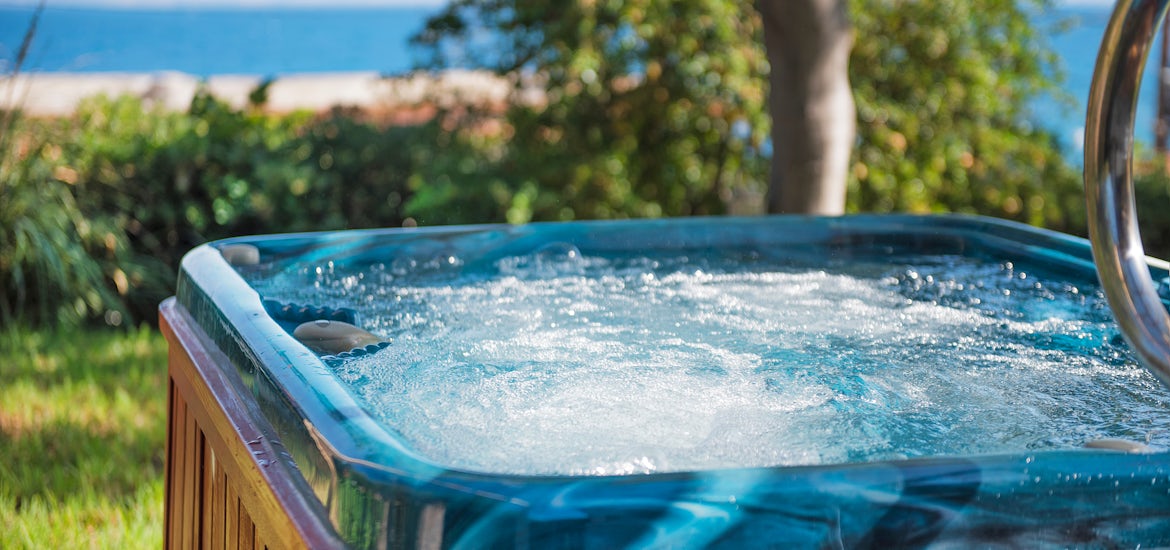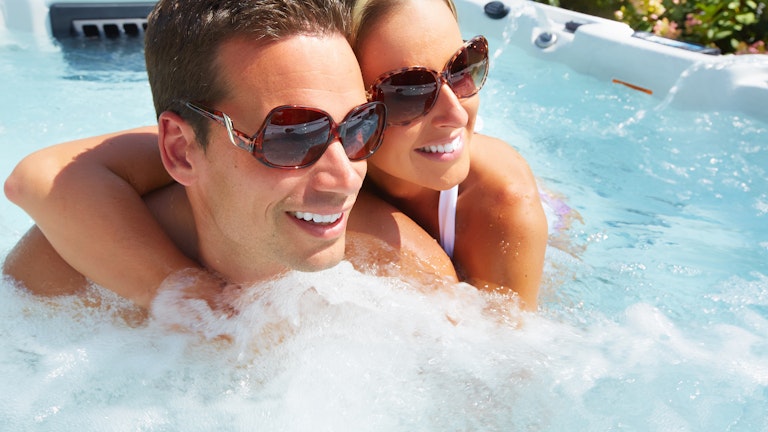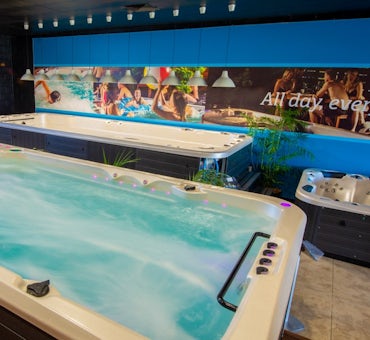At the time time of writing, Spa World does not offer saltwater systems or saltwater spa pools for sale. This article offers a helpful guide for anyone looking for tips on maintaining a saltwater spa.
How do I maintain my saltwater spa pool?
Looking to maintain your saltwater swim spa? Check out this comprehensive guide, including tips for proper water chemistry, cleaning and maintaining the salt cell, adding additional chlorine sanitizer, and practicing good hygiene habits.

In this article, we cover commonly asked questions about maintaining salt water in a spa pool.
Saltwater spa pools have several benefits over traditional spas that use chlorine or other sanitisers. Some of the key benefits of a saltwater spa pool include:
Softer water: Saltwater spa pools have softer water that is gentler on the skin and eyes. This can be especially beneficial for people with sensitive skin or allergies.
Lower chlorine levels: Saltwater spa pools generate chlorine through a salt cell, which means that they require less additional chlorine sanitiser to maintain proper water chemistry. This can result in lower chlorine levels in the water, which can be more pleasant for bathers and reduce the risk of skin irritation or other problems.
Reduced maintenance: Saltwater spa pools generally require less maintenance than traditional spa poolss. Because the water chemistry is self-regulating to a certain extent, owners can spend less time adding chemicals and more time enjoying their spa.
Longer lifespan: Saltwater spa pools can have a longer lifespan because the salt cell helps to reduce the amount of wear and tear on the pump and other components. This can result in fewer repairs and replacements over time.
This article provides a comprehensive guide to maintaining a saltwater spa pool, including tips for proper water chemistry, cleaning and maintaining the salt cell.
By following these guidelines, bathers can ensure a clean and healthy environment for soaking and relaxing, while extending the lifespan of their saltwater spa pool. Whether you are a seasoned hot tub owner or new to the world of saltwater spas, this guide will provide valuable information for maintaining your tub and enjoying a safe and comfortable soak every time.
How do I maintain my saltwater spa pool?
Maintaining a saltwater spa pool involves a few key steps:
- Monitor water chemistry: Regularly test the water using a test kit to ensure the pH, alkalinity, and chlorine levels are within the recommended range. This helps to prevent scaling, corrosion, and bacterial growth.
- Balance the water: Adjust the water chemistry as needed using appropriate chemicals. For example, if the pH is too high, you may need to add an acid to lower it. If the alkalinity is too low, you may need to add a base to raise it.
- Clean the filter: The filter should be cleaned regularly to prevent clogging and to maintain water flow. This can be done by removing the filter and rinsing it with a hose or using a filter cleaner solution.
- Drain and refill the water: Over time, the water will become saturated with dissolved solids and other contaminants. It is recommended to drain and refill the water every 3-4 months, or as needed based on water quality tests.
- Monitor salt levels: Salt levels should be monitored regularly, as high or low salt levels can cause problems with the equipment in your spa. Follow the manufacturer's recommendations for maintaining appropriate salt levels.
- Clean the spa: Regularly clean the surfaces of the spa with a non-abrasive cleaner and a soft cloth to prevent the buildup of dirt, oils, and other contaminants.
How often should I add salt to my saltwater spa pool?
The frequency of adding salt to a saltwater spa pool will depend on a few factors, including the initial salt level, the size of the spa, and the frequency of water changes.
When you first fill your spa or hot tub with water, you will need to add the appropriate amount of salt according to the manufacturer's instructions.
- For a swim spa of 5,000L, to reach an ideal salt level of 1,800 PPM, you should add approximately 9kg of salt.
- For a swim spa of 10,000L, to reach an ideal salt level of 1,800 PPM, you should add approximately 18kg of salt
- Add a smaller amount first and test - you can always add more if needed!
After the initial addition of salt, you will typically only need to add more salt if you have drained and refilled the spa, or if you have lost water due to splashing, evaporation, or other factors. In a Vortex® swim spa you should aim to maintain a salt level of between 1,500-2,000 parts per million (ppm) in your spa pool. Check with your spa manufacturer to confirm the recommended levels in your spa.
To determine if you need to add salt, you can test the water using a saltwater test strip or meter. If the salt level is below the recommended range, you can add salt in small increments, following the manufacturer's instructions for the amount needed based on your spa pool's size.
It's important not to add too much salt, as this can lead to equipment damage and other problems. Be sure to test the water regularly and adjust the salt level as needed to maintain proper water chemistry and avoid any issues.
Do I need to add chlorine sanitiser to my saltwater spa?
While a saltwater spa does generate its own chlorine through the salt cell, you may need to add sanitiser in the water to ensure proper disinfection.
The chlorine generated by the salt cell is not always sufficient to maintain a consistent level of sanitiser in the water, especially during periods of heavy use or when the water is exposed to contaminants such as leaves, debris, or oils from swimmers' bodies. Adding additional sanitiser can help to ensure that the water is properly disinfected and safe for use.
The amount of additional chlorine sanitiser needed will depend on a few factors, including the size of the spa, the frequency of use, and the water quality. As a general guideline, you may need to add a small amount of chlorine sanitiser to the water every few weeks, or as needed based on water quality tests.
Be sure to use a chlorine sanitiser that is compatible with saltwater systems and follow the manufacturer's instructions for proper dosing and application. It's also important to test the water regularly to ensure that the sanitiser levels are within the recommended range and adjust as needed.
Do I need to shock my saltwater spa pool?
Yes, it is recommended that you shock your saltwater spa pool periodically. Shocking the water with a high dose of chlorine or other sanitiser helps to destroy any bacteria, algae, and other organic matter that may be present in the water. This can help to keep the water clean, clear, and safe for soaking.
The frequency of shock treatments will depend on the usage of your spa pool and the water quality. As a general guideline, it is recommended to shock the water every 1-2 weeks or after heavy usages, such as a party or a period of extended use. You may also need to shock the water if you notice cloudiness, odour, or other signs of poor water quality.
Be sure to follow the manufacturer's instructions for shock treatment, including the appropriate dosage and waiting period before re-entering the spa pool. Also, remember to test the water regularly to ensure that the sanitiser levels are within the recommended range, and adjust as needed.
How often should I change the water in my saltwater spa pool?
It is recommended that you change the water in your saltwater spa pool every 3-4 months, or as needed based on water quality tests. Over time, the water in the spa will become saturated with dissolved solids and other contaminants, which can affect the water chemistry and potentially cause skin irritation or other problems.
In addition to regular water changes, you should also maintain proper water chemistry and cleanliness to help extend the life of the water. This includes monitoring and adjusting pH, alkalinity, and sanitiser levels, cleaning the filter regularly, brushing the spa surfaces, and maintaining proper water circulation.
If you notice any signs of poor water quality, such as cloudiness, odour, or skin irritation, you may need to change the water more frequently. It's also a good idea to drain and refill the spa if it has been unused for an extended period of time, such as over the winter months.

How often do I need to change the salt cell in my saltwater spa pool?
The frequency of replacing the salt cell in a saltwater spa pool will depend on a few factors, including the usage of the pool and the maintenance of the cell.
A salt cell is the component of the saltwater system that converts salt into chlorine. Over time, the cell can become coated with mineral buildup and other debris, which can reduce its efficiency and effectiveness in generating chlorine.
As a general guideline, it is recommended to inspect the salt cell every 3-4 months for signs of buildup or wear. If the cell appears to be coated with scale or debris, you may need to clean it using a specialized cell cleaner according to the manufacturer's instructions.
In addition to regular cleaning, you may need to replace the salt cell every 2-5 years, depending on usage and maintenance. Signs that it may be time to replace the cell include a drop in chlorine production, poor water quality, or a warning or error message from the saltwater system.
Be sure to follow the manufacturer's instructions for cleaning and replacing the salt cell, and test the water regularly to ensure proper chlorine levels and water chemistry. With proper maintenance, you can extend the life of your salt cell and ensure a clean and healthy spa pool environment.
Should I shower before and after I use my saltwater spa?
Yes, it is recommended to shower both before and after using a saltwater spa.
Showering before using the spa helps to remove any dirt, oils, and other contaminants from your skin, which can reduce the amount of these substances that enter the water. This can help to maintain proper water chemistry and reduce the amount of sanitiser needed to keep the water clean.
Showering after using the spa can help to remove any residual chlorine or other chemicals from your skin, which can help to prevent skin irritation or other problems. It can also help to remove any dirt, oils, or other substances that may have been introduced into the water during use.
In addition to showering, it is also important to avoid using lotions, oils, or other products on your skin before using the spa, as these can interfere with water chemistry and lead to problems such as cloudiness or skin irritation.

How do I avoid algae in my saltwater spa?
- Monitor and maintain proper water chemistry: Algae growth is more likely to occur in water that is unbalanced or has inadequate sanitiser levels. Be sure to regularly test the water and adjust the pH, alkalinity, and chlorine levels as needed to maintain a healthy environment.
- Clean the filter: A dirty or clogged filter can create an environment where algae can grow. Regularly clean the filter and replace it when necessary.
- Use a shock treatment: Shocking the spa with a high dose of chlorine or another sanitiser can help to kill any algae that may be present. Follow the manufacturer's instructions for shock treatment.
- Brush the surfaces: Use a soft-bristled brush to scrub the walls and other surfaces. This can help to dislodge any algae that may be present and prevent it from growing.
- Maintain proper water circulation: Good water circulation is important to prevent stagnant water and promote even distribution of sanitiser. Ensure that the pumps and jets are working properly.
- Keep the spa covered: Sunlight can promote algae growth, so it's important to ensure your spa cover is in good condition and that it is securely fixed in place.
In Summary
Maintaining a saltwater spa pool requires regular upkeep to ensure proper water chemistry and a clean, healthy environment for bathers. This includes regular testing of water chemistry, adding appropriate levels of salt to the water, cleaning the salt cell, and adding additional chlorine sanitiser as needed.
Bathers should also practice good hygiene habits, including showering both before and after use, to help reduce contaminants that enter the water.
With proper maintenance and care, a saltwater spa pool can provide a relaxing and enjoyable experience for years to come.


